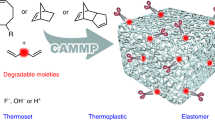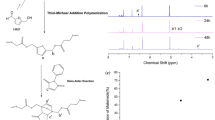Abstract
Thermoset plastics have become one of the most important chemical products in the world. The consequent problem is that although the thermosets possess excellent performance in mechanical strength, they cannot be reprocessed because of the internal permanent network structures. Optimizing the molecular design of thermosets is one of the most feasible ways to improve their recyclability. Here we present a facile and robust strategy to engineer the reprocessability of thermoset polyurethanes without compromising their mechanical toughness and chemical resistance via adding supramolecular additives during the polymer synthesis process. By using a multiple hydrogen bonding moiety as the model supramolecular additive, we demonstrate that the mechanical properties, recyclability, and chemical resistance of the crosslinked polyurethanes can be precisely controlled by adjusting the contents of the supramolecular additive. Systematic studies on the relations between molecular design and material properties are performed, and the optimized polyurethane network with a moderate amount of the supramolecular additive achieves the right balance between the robustness and recyclability. This work provides a cost-effective and practical way to chemically engineer thermoset plastics, aiming to enable the recycling of mechanically tough and chemically stable polymer materials.
Similar content being viewed by others
References
Zhang, Y.; Zhang, L.; Yang, G.; Yao, Y.; Wei, X.; Pan, T.; Wu, J.; Tian, M.; Yin, P. Recent advances in recyclable thermosets and thermoset composites based on covalent adaptable networks. J. Mater. Sci. Technol. 2021, 92, 75–87.
Zhu, J. B.; Watson, E. M.; Tang, J.; Chen, E. Y. X. A synthetic polymer system with repeatable chemical recyclability. Science 2018, 360, 398–403.
Long, T. E. Toward recyclable thermosets. Science 2014, 344, 706–707.
Liu, J.; Wang, S.; Peng, Y.; Zhu, J.; Zhao, W.; Liu, X. Advances in sustainable thermosetting resins: from renewable feedstock to high performance and recyclability. Prog. Polym. Sci. 2021, 113, 101353.
Jehanno, C.; Sardon, H. A step towards truly recyclable plastics. Nature 2019, 568, 467–468.
Shieh, P.; Zhang, W.; Husted, K. E. L.; Kristufek, S. L.; Xiong, B.; Lundberg, D. J.; Lem, J.; Veysset, D.; Sun, Y.; Nelson, K. A.; Plata, D. L.; Johnson, J. A. Cleavable comonomers enable degradable, recyclable thermoset plastics. Nature 2020, 583, 542–547.
Montarnal, D.; Capelot, M.; Tournilhac, F.; Leibler, L. Silica-like malleable materials from permanent organic networks. Science 2011, 334, 965–968.
Millican, J. M.; Agarwal, S. Plastic pollution: a material problem? Macromolecules 2021, 54, 4455–4469.
MacLeod, M.; Arp, H. P. H.; Tekman, M. B.; Jahnke, A. The global threat from plastic pollution. Science 2021, 373, 61–65.
Chen, X.; Dam, M. A.; Ono, K.; Mal, A.; Shen, H.; Nutt, S. R.; Sheran, K.; Wudl, F. A thermally re-mendable cross-linked polymeric material. Science 2002, 295, 1698–1702.
Stubbins, A.; Law, K. L.; Muñoz, S. E.; Bianchi, T. S.; Zhu, L. Plastics in the earth system. Science 2021, 373, 51–55.
Sheppard, D. T.; Jin, K.; Hamachi, L. S.; Dean, W.; Fortman, D. J.; Ellison, C. J.; Dichtel, W. R. Reprocessing postconsumer polyurethane foam using carbamate exchange catalysis and twin-screw extrusion. ACS Cent. Sci. 2020, 6, 921–927.
Luong, D. X.; Bets, K. V.; Algozeeb, W. A.; Stanford, M. G.; Kittrell, C.; Chen, W.; Salvatierra, R. V.; Ren, M.; McHugh, E. A.; Advincula, P. A.; Wang, Z.; Bhatt, M.; Guo, H.; Mancevski, V.; Shahsavari, R.; Yakobson, B. I.; Tour, J. M. Gram-scale bottom-up flash graphene synthesis. Nature 2020, 577, 647–651.
Korley, L. T. J.; Epps, T. H.; Helms, B. A.; Ryan, A. J. Toward polymer upcycling-adding value and tackling circularity. Science 2021, 373, 66–69.
Zhong, Y.; Li, P.; Wang, X.; Hao, J. Amoeba-inspired reengineering of polymer networks. Green Chem. 2021, 23, 2496–2506.
Wang, X.; Zhan, S.; Lu, Z.; Li, J.; Yang, X.; Qiao, Y.; Men, Y.; Sun, J. Healable, recyclable, and mechanically tough polyurethane elastomers with exceptional damage tolerance. Adv. Mater. 2020, 32, 2005759.
Zhang, C.; Yang, Z.; Duong, N. T.; Li, X.; Nishiyama, Y.; Wu, Q.; Zhang, R.; Sun, P. Using dynamic bonds to enhance the mechanical performance: from microscopic molecular interactions to macroscopic properties. Macromolecules 2019, 52, 5014–5025.
Rowan, S. J.; Cantrill, S. J.; Cousins, G. R. L.; Sanders, J. K. M.; Stoddart, J. F. Dynamic covalent chemistry. Angew. Chem. Int. Ed. 2002, 41, 898–952.
Ma, S.; Webster, D. C. Degradable thermosets based on labile bonds or linkages: a review. Prog. Polym. Sci 2018, 76, 65–110.
Lu, X.; Bao, C.; Xie, P.; Guo, Z.; Sun, J. Solution-processable and thermostable super-strong poly(aryl ether ketone) supramolecular thermosets cross-linked with dynamic boroxines. Adv. Funct. Mater. 2021, 31, 2103061.
Kuhl, N.; Bode, S.; Bose, R. K.; Vitz, J.; Seifert, A.; Hoeppener, S.; Garcia, S. J.; Spange, S.; van der Zwaag, S.; Hager, M. D.; Schubert, U. S. Acylhydrazones as reversible covalent crosslinkers for self-healing polymers. Adv. Funct. Mater 2015, 25, 3295–3301.
Gao, Y.; Liu, W.; Zhu, S. Reversible shape memory polymer from semicrystalline poly(ethylene-co-vinyl acetate) with dynamic covalent polymer networks. Macromolecules 2018, 51, 8956–8963.
Fortman, D. J.; Sheppard, D. T.; Dichtel, W. R. Reprocessing cross-linked polyurethanes by catalyzing carbamate exchange. Macromolecules 2016, 52, 6330–6335.
Zhong, Y.; Li, P.; Hao, J.; Wang, X. Bioinspired self-healing of kinetically inert hydrogels mediated by chemical nutrient supply. ACS Appl. Mater. Interfaces 2020, 12, 6471–6478.
Mocny, P.; Klok, H. A. Reversibly cross-linking polymer brushes using interchain disulfide bonds. Macromolecules 2020, 53, 731–740.
Cui, C.; Chen, X.; Ma, L.; Zhong, Q.; Li, Z.; Mariappan, A.; Zhang, Q.; Cheng, Y.; He, G.; Chen, X.; Dong, Z.; An, L.; Zhang, Y. Polythiourethane covalent adaptable networks for strong and reworkable adhesives and fully recyclable carbon fiber-reinforced composites. ACS Appl. Mater. Interfaces 2020, 12, 47975–47983.
Post, W.; Susa, A.; Blaauw, R.; Molenveld, K.; Knoop, R. J. I. A review on the potential and limitations of recyclable thermosets for structural applications. Polym. Rev. 2019, 60, 359–388.
Yin, Z.; Song, G.; Jiao, Y.; Zheng, P.; Xu, J. F.; Zhang, X. Dissipative supramolecular polymerization powered by light. CCS Chem. 2019, 1, 335–342.
Zhu, J.; Chen George, Y.; Yu, L.; Xu, H.; Liu, X.; Sun, J. Mechanically strong and highly stiff supramolecular polymer composites repairable at ambient conditions. CCS Chem. 2019, 2, 280–292.
Zhang, S.; Qin, B.; Xu, J. F.; Zhang, X. Multi-recyclable shape memory supramolecular polyurea with long cycle life and superior stability. ACS Mater. Lett. 2021, 5, 331–336.
Sun, P.; Li, Y.; Qin, B.; Xu, J. F.; Zhang, X. Super strong and multi-reusable supramolecular epoxy hot melt adhesives. ACS Mater. Lett. 2021, 3, 1003–1009.
Du, L.; Xu, Z. Y.; Fan, C. J.; Xiang, G.; Yang, K. K.; Wang, Y. Z. A fascinating metallo-supramolecular polymer network with thermal/magnetic/light-responsive shape-memory effects anchored by Fe3O4 nnnoparticles. Macromolecules 2018, 51, 705–715.
An, N.; Wang, X.; Li, Y.; Zhang, L.; Lu, Z.; Sun, J. Healable and mechanically super-strong polymeric composites derived from hydrogen-bonded polymeric complexes. Adv. Mater. 2019, 31, 1904882.
Liu, X.; Wu, D.; Wang, H.; Wang, Q. Self-recovering tough gel electrolyte with adjustable supercapacitor performance. Adv. Mater. 2014, 26, 4370–4375.
Luo, F.; Sun, T. L.; Nakajima, T.; Kurokawa, T.; Ihsan, A. B.; Li, X.; Guo, H.; Gong, J. P. Free reprocessability of tough and self-healing hydrogels based on polyion complex. ACS Macro Lett. 2015, 4, 961–964.
Xu, S.; Chang, P.; Zhao, B.; Adeel, M.; Zheng, S. Formation of poly(ε-caprolactone) networks via supramolecular hydrogen bonding interactions. Chinese J. Polym. Sci. 2019, 37, 197–207.
Shi, J.; Zhao, N.; Yan, D.; Song, J.; Fu, W.; Li, Z. Design of a mechanically strong and highly stretchable thermoplastic silicone elastomer based on coulombic interactions. J. Mater. Chem. A 2020, 8, 5943–5951.
Li, Z.; Zhu, Y. L.; Niu, W.; Yang, X.; Jiang, Z.; Lu, Z. Y.; Liu, X.; Sun, J. Healable and recyclable elastomers with record-high mechanical robustness, unprecedented crack tolerance, and superhigh elastic restorability. Adv. Mater. 2021, 33, 2101498.
Qin, B.; Zhang, S.; Sun, P.; Tang, B.; Yin, Z.; Cao, X.; Chen, Q.; Xu, J. F.; Zhang, X. Tough and multi-recyclable cross-linked supramolecular polyureas via incorporating noncovalent bonds into main-chains. Adv. Mater. 2020, 32, 2000096.
Street, D. P.; Ledford, W. K.; Allison, A. A.; Patterson, S.; Pickel, D. L.; Lokitz, B. S.; Messman, J. M.; Kilbey, S. M. Self-complementary multiple hydrogen-bonding additives enhance thermomechanical properties of 3D-printed PMMA structures. Macromolecules 2019, 52, 5574–5582.
Söntjens, S. H. M.; Sijbesma, R. P.; van Genderen, M. H. P.; Meijer, E. W. Stability and lifetime of quadruply hydrogen bonded 2-ureido-4[1H]-pyrimidinone dimers. J. Am. Chem. Soc. 2000, 122, 7487–7493.
Li, T.; Zheng, T. Z.; Guo, Z. X.; Xu, J.; Guo, B. H. A well-defined hierarchical hydrogen bonding strategy to polyureas with simultaneously improved strength and toughness. Chinese J. Polym. Sci. 2019, 37, 1257–1266.
Li, X.; Li, J.; Wei, W.; Yang, F.; Wu, M.; Wu, Q.; Xie, T.; Chen, Y. Enhanced mechanochemiluminescence from end-functionalized polyurethanes with multiple hydrogen bonds. Macromolecules 2021, 54, 1557–1563.
Sijbesma, R. P.; Beijer, F. H.; Brunsveld, L.; Folmer, B. J. B.; Hirschberg, J. H. K. K.; Lange, R. F. M.; Lowe, J. K. L.; Meijer, E. W. Reversible polymers formed from self-complementary monomers using quadruple hydrogen bonding. Science 1997, 278, 1601–1604.
Zhang, L.; Qiu, T.; Sun, X.; Guo, L.; He, L.; Ye, J.; Li, X. Achievement of both mechanical properties and intrinsic self-healing under body temperature in polyurethane elastomers: a synthesis strategy from waterborne polymers. Polymers 2020, 12, 989.
Zhang, X.; Wang, Y.; Sun, S.; Hou, L.; Wu, P.; Wu, Z.; Zheng, Q. A tough and stiff hydrogel with tunable water content and mechanical properties based on the synergistic effect of hydrogen bonding and hydrophobic interaction. Macromolecules 2018, 51, 8136–8146.
Guo, Y.; Qu, X.; Hu, Z.; Zhu, J.; Niu, W.; Liu, X. Highly elastic and mechanically robust polymer electrolytes with high ionic conductivity and adhesiveness for high-performance lithium metal batteries. J. Mater. Chem. A 2021, 9, 13597–13607.
Liu, X.; Zhong, M.; Shi, F.; Xu, H.; Xie, X. Multi-bond network hydrogels with robust mechanical and self-healable properties. Chinese J. Polym. Sci. 2017, 35, 1253–1267.
Song, Y.; Liu, Y.; Qi, T.; Li, G. Towards dynamic but supertough healable polymers through biomimetic hierarchical hydrogen-bonding interactions. Angew. Chem. Int. Ed. 2018, 57, 13838–13842.
Zheng, N.; Fang, Z.; Zou, W.; Zhao, Q.; Xie, T. Thermoset shape-memory polyurethane with intrinsic plasticity enabled by transcarbamoylation. Angew. Chem. Int. Ed. 2013, 55, 11421–11425.
Acknowledgments
This study was financially supported by the National Natural Science Foundation of China (No. 21975145). The authors acknowledge the assistance of Shandong University Structural Constituent and Physical Property Research Facilities/SDU SC&PP Research Facilities for polymer characterization.
Author information
Authors and Affiliations
Corresponding author
Additional information
Notes
The authors declare no competing financial interest.
Electronic Supplementary Information
10118_2022_2651_MOESM1_ESM.pdf
Insertion of Supramolecular Segments into Covalently Crosslinked Polyurethane Networks towards the Fabrication of Recyclable Elastomers
Rights and permissions
About this article
Cite this article
Wang, LP., Zhang, MG., Hao, JC. et al. Insertion of Supramolecular Segments into Covalently Crosslinked Polyurethane Networks towards the Fabrication of Recyclable Elastomers. Chin J Polym Sci 40, 321–330 (2022). https://doi.org/10.1007/s10118-022-2651-2
Received:
Accepted:
Published:
Issue Date:
DOI: https://doi.org/10.1007/s10118-022-2651-2




